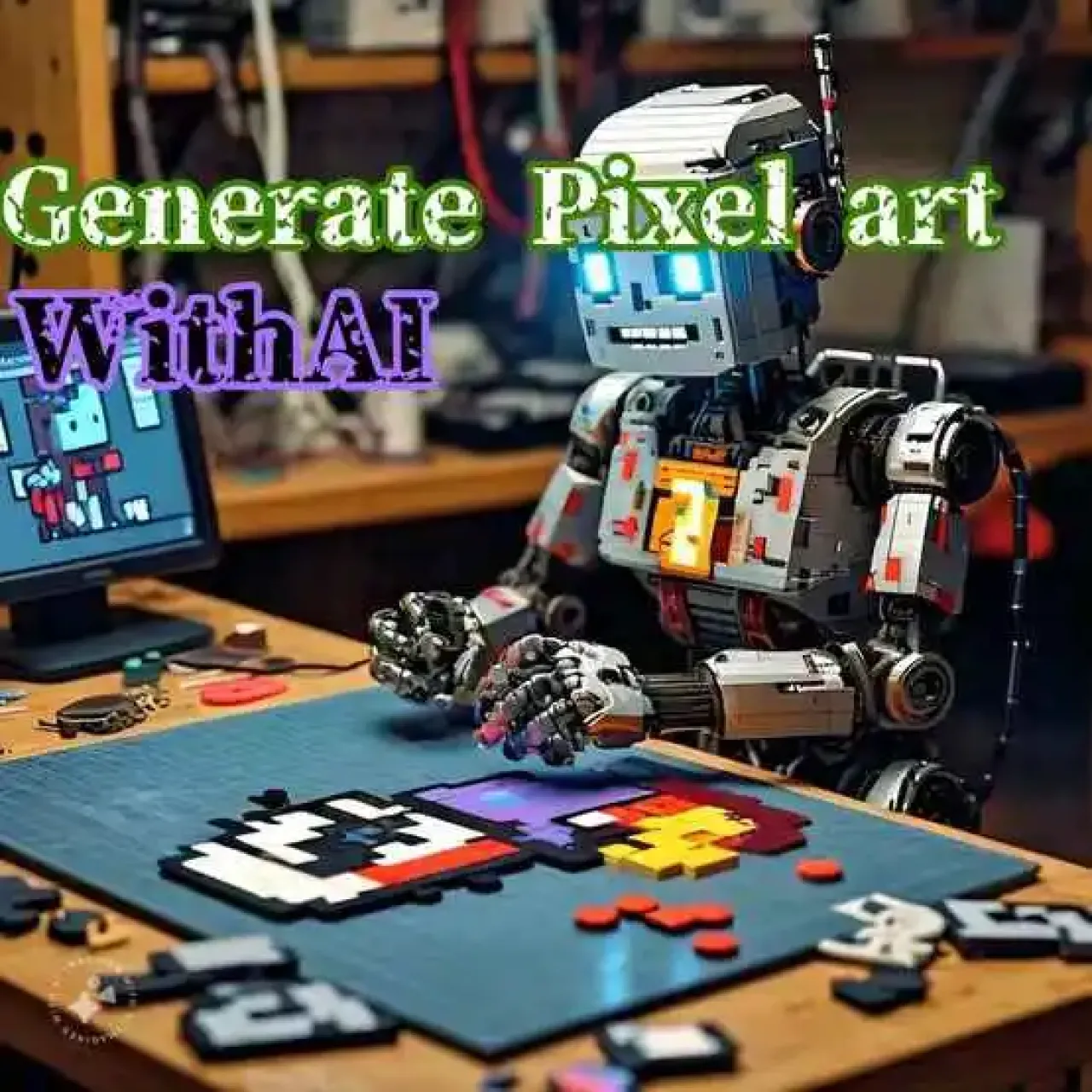Modern Pixel Art with AI: Create and Innovate with Top AI Tools

Introduction AI Pixel Art
In the realm where art meets technology, pixel art is a testament to creativity within constraints. Originating from the early days of computing, pixel art has evolved into a distinct form that continues to captivate artists and audiences alike. This comprehensive guide explores the world of pixel art, from its history and techniques to its modern applications and potential pitfalls.
What is Pixel Art?
The high-level overview of the Athena is as follows Definition – The Analyzer and SQL editor Characteristics:
An Introduction To Pixel Art: History and Theory of Pixel Every pixel is like a brick in the wall, carefully stacking up to create detailed patterns and characters or scenes. The art style involves a lot of blocky design and simple colors to keep everything smooth.
Historical Development
Pixel art emerged in the 1970s and 1980s when video games and computers were still electronic. Artists morphed toward aesthetic and nostalgic appeal—an old crutch of necessity turned trend.
Importance and Relevance Today:
Pixel art is still widely used, even with all of today's advancements in graphical capabilities. How these abstract visual designs explain such deep concepts is a sweet spot that indie games, animations, and digital art projects have been hitting for ages. On top of this, it also marries the best-of-breed between modern technology and retro aesthetics, thus offering a seriously compelling choice for pro gamers and an affordable introduction to newcomers.
Pixel styles and categories
Classic Pixel Art
Classic Pixel Art is a traditional style based on video game graphics from decades ago. It is designed to be simple, often using an 8-bit or 16-bit color palette.
Isometric Pixel Art
Isometric pixel art is a pseudo-3D style made to simulate 3D space. This technique is frequently employed in strategy games and architectural drafting.
Animated Pixel Art
Animated pixel art involves creating pixelated images that serve as moving parts, like in video game sprites and animated shorts.
Modern Pixel Art
Contemporary pixel art combines new modern design while keeping the quintessence of pixels. It typically includes higher resolutions and more advanced shading techniques.
Techniques Used in Pixel Art
Pixel Placement
In pixel art, the artist places every dot manually. Techniques include dithering (creating patterns of varying pixel densities) and anti-aliasing to smooth the edges.
Color Theory in Pixel Art
This is key in pixel art whenever a sound palette of colors is chosen. Restraining your color palette can add impact and unify the look, with sparing shading adding that little touch of reality.
Scaling and Resolution
Since pixel art can be scaled up or down without losing effectiveness and clarity, it is an excellent tool for all sorts of application sizes.
Benefits of Pixel Art
Nostalgic Appeal
Pixel art feels retro and nostalgic, reminiscent of early computing or video games that most can appreciate.
Technical Advantages
Because it is less computationally intensive, pixel art is a perfect choice for mobile games, web graphics, and low-budget projects.
Artistic Freedom
Oh, and pixel art is an amazing tool for being creative within certain boundaries. It is a stylistic playground for artists to play around with different types of style, composition, and storytelling within the pixelated world.
Challenges and Limitations
Detail Constraints
Pixel art details can be quite complex and tricky to implement. As an artist, you must always balance complexity and clarity, even more so for smaller resolutions.
Learning Curve
However, like all things in life, it will take some time to practice htonlpixel art techniques. Diligence and artistic feeling for pixel placement, color theory, and animation
Perception in Modern Art
Even though pixel art has become more popular, it is still often considered inferior to high-definition digital forms of artwork.
Applications of Pixel Art
Video Games
Pixel art is a cornerstone of the indie game experience, providing distinct visuals and play. But titles such as "Stardew Valley" and "Celeste" have proved the enduring popularity of this type of game.
Digital Illustration
Thanks to its unique design, artists use pixel art as illustrations, logos, and easily scalable icons.
Animation
Both short films and web series use pixel art animation for their appealing visuals and to create dynamic narratives.
Pixel Art Setup Guide
Tools and Software
Check out Pixaki because Aseprite and GraphicsGale are commonly used as pixel art tools. These programs are helpful for pixel manipulation and animation.
Tutorials and Resources
There are online tutorials and communities (such as PixelJoint and Pixelation, among others) that can help you learn techniques or receive feedback from other artists.
Practice and Experimentation
Simple projects are a good place for beginners to experiment and slowly progress to more elaborate compositions, such as pop arrangements.
Conclusion
Pixel art thrives as a unique blend of artistic expression and technological innovation. Whether you're drawn to its nostalgic charm or technical challenges, pixel art remains a vibrant medium that pushes the boundaries of creativity. By understanding its history, mastering its techniques, and exploring its modern applications, artists can embrace pixel art as a timeless and dynamic form of visual storytelling.
FAQs About Pixel Art
1. What are the essential tools for creating pixel art?
To create pixel art, you'll need:
- Pixel Art Editor: Software like Aseprite, GraphicsGale, or Pixaki, which are designed specifically for pixel manipulation and animation.
- Graphics Tablet: Optional but recommended for precise input, beneficial for detailed pixel placement.
- Color Palette: Understanding and selecting a suitable color palette is crucial for achieving the desired aesthetic.
2. Can pixel art be used commercially?
Yes, pixel art is widely used in various commercial applications:
- Video Games: Many indie games feature pixel art due to its nostalgic appeal and technical advantages.
- Digital Illustrations: In digital media, pixel art is used for icons, logos, and illustrations.
- Advertisements: Pixel art can be used creatively in marketing campaigns to stand out and evoke a retro feel.
3. Is pixel art only suitable for retro-style projects?
While pixel art originated from retro video games, its versatility allows for diverse applications:
- Modern Art: Contemporary artists use pixel art techniques to explore themes and styles beyond retro aesthetics.
- Animation: Pixel art animation is popular for short films and web series and is appreciated for its unique visual style and storytelling potential.
4. What are some tips for beginners interested in learning pixel art?
Getting started with pixel art can be rewarding with these tips:
- Start Simple: Begin with small projects to grasp basic techniques like pixel placement and shading.
- Study Color Theory: Understanding color theory is crucial for creating visually appealing pixel art.
- Join Communities: Online communities and tutorials provide valuable feedback and resources to improve your skills.
5. How does pixel art compare to other digital art forms like vector art?
Pixel art and vector art differ in several aspects:
- Resolution: Pixel art relies on individual pixels, maintaining clarity at specific resolutions. Vector art uses mathematical formulas, allowing infinite scalability without losing quality.
- Style: Pixel art often emphasizes retro aesthetics and limited color palettes, while vector art focuses on clean lines and scalability.
- Applications: Pixel art is prevalent in games and digital illustrations, whereas vector art is typical in logos, technical drawings, and print media.
6. What are the copyright considerations when using or creating pixel art?
When using pixel art:
- Originality: Ensure your pixel art is original or appropriately licensed to avoid copyright infringement.
- Attribution: If using pixel art created by others, give proper credit to the artist and comply with their licensing terms.
- Commercial Use: Be aware of any restrictions regarding the commercial use of pixel art, mainly if you sell or distribute your work.
7. How can I improve my pixel art skills over time?
Improving your pixel art skills requires dedication and practice:
- Practice Regularly: Dedicate time to creating pixel art and experimenting with new techniques.
- Receive Feedback: Join online forums or communities where you can share your work and receive constructive criticism.
- Study Masterpieces: Analyze pixel art from renowned artists to learn advanced techniques and styles.
8. What are some notable examples of pixel art in popular culture?
Pixel art has left a significant mark on popular culture:
- Video Games: Titles like "Minecraft," "Super Mario Bros.," and "Undertale" showcase diverse uses of pixel art in gaming.
- Film and Animation: Short films like "Pixel" and web animations on platforms like YouTube demonstrate the storytelling capabilities of pixel art.
- Art Exhibitions: Pixel art has been featured worldwide in art galleries and exhibitions, highlighting its artistic merit and cultural impact.






